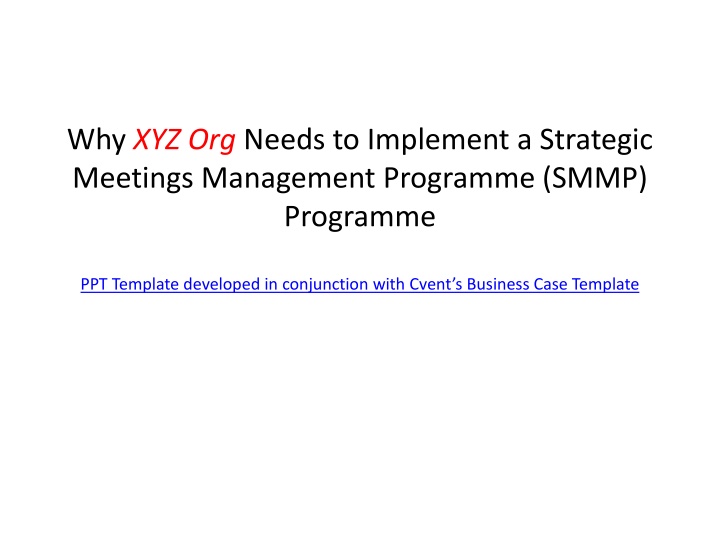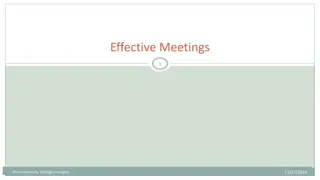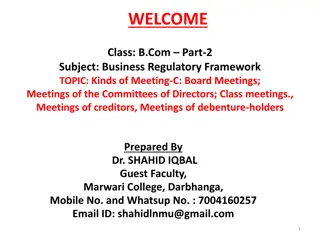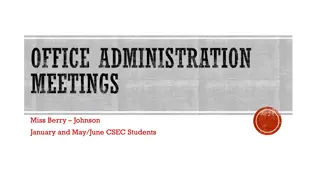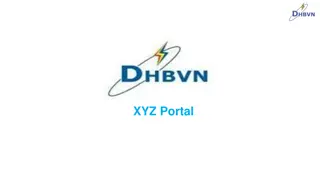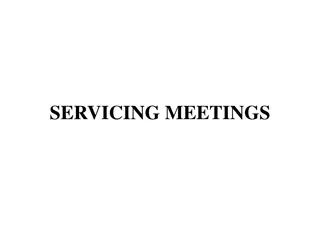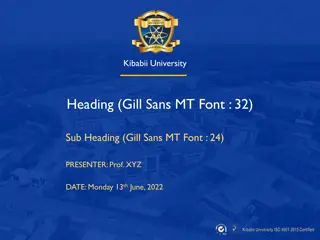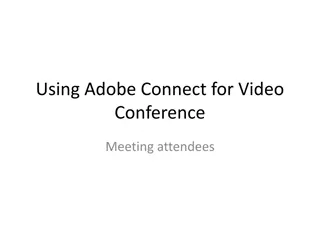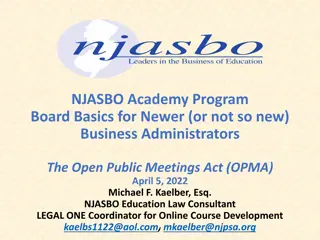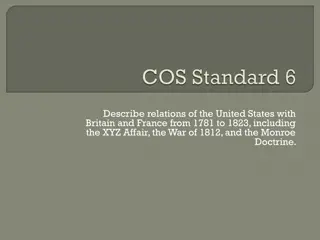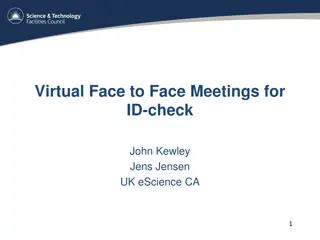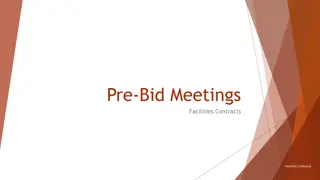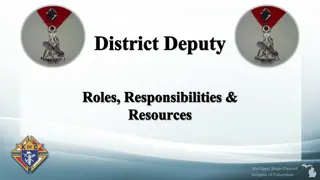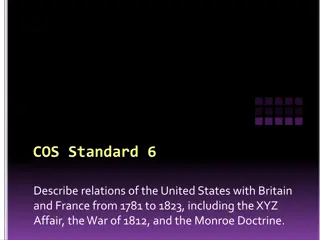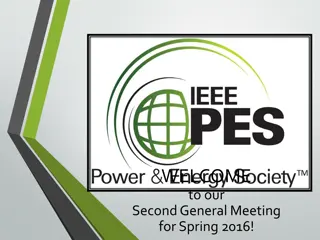Implementing Strategic Meetings Management for XYZ Org
Meetings and events can account for a significant portion of an organization's expenses, making it crucial to implement a Strategic Meetings Management Programme (SMMP) to enhance visibility, reduce costs, and improve decision-making. This comprehensive solution, developed in conjunction with Cvent's Business Case Template, can lead to substantial savings, increased ROI, and better management of meeting activities and supplier relationships.
Download Presentation

Please find below an Image/Link to download the presentation.
The content on the website is provided AS IS for your information and personal use only. It may not be sold, licensed, or shared on other websites without obtaining consent from the author.If you encounter any issues during the download, it is possible that the publisher has removed the file from their server.
You are allowed to download the files provided on this website for personal or commercial use, subject to the condition that they are used lawfully. All files are the property of their respective owners.
The content on the website is provided AS IS for your information and personal use only. It may not be sold, licensed, or shared on other websites without obtaining consent from the author.
E N D
Presentation Transcript
Why XYZ Org Needs to Implement a Strategic Meetings Management Programme (SMMP) Programme PPT Template developed in conjunction with Cvent s Business Case Template
Industry Statistics Meetings and events are a major spend category: a. Meeting spend accounts for 25 to 40% of the organisation s annual travel spend or 1 to 3% of company revenues. b. It is estimated that 10 25% savings can be achieved through the implementation of a robust SMMP aided by state-of-the-art technology [INSERT APPLICABLE STATISTICS]
Potential Impact to XYZ Org 1. Cvent s ROI Calculator shows a: a. ___ % return on investment in meetings management technology in Year 1; b. ___% ROI in Year 2; and c. ___% ROI in Year 3.
Current Situation Limited Visibility Into Meeting Activity Limited visibility results in: 1. Inability to make quick decisions about meetings and events. 2. High risk factors associated with meetings, such as: a. Global Duty of Care b. Attendee/traveler safety c. Inadequate insurance coverage necessary for certain meetings d. Unintended contractual risks. e. Ability to pivot quickly during crisis 3. Limited ability to manage compliance with corporate purchasing policies or legal processes such as: a. Signature authority levels b. Master Service Agreements (MSAs) c. Meetings contracted without the appropriate approvals. According to research by Aberdeen, The gain of visibility into the strategic meetings space will reduce cost and improve savings by over 50%.
Current Situation Limited Visibility Into Meeting Activity (cont d) 3. Unawareness into: a. b. c. Cancelled space credits available for re-use; Other penalty-related funds available for meetings; Meetings that overlap in the same location resulting in lost opportunity to negotiate based on full financial impact; and Cancellation of meetings due to unawareness of participant unavailability Executives, speakers, other key attendees, etc d. In looking into meetings data, we found that __________ meetings were cancelled in the past year, resulting in the loss of __________.
Current Situation Lost Savings Opportunities Fragmented purchasing leads to: 1. Lack of awareness of total meeting/event costs and inability to effectively manage event budgets. 2. Inability to fully leverage spend or economies of scale with suppliers due to transparency and lack of critical usage and spend data. 3. Inability to develop a preferred supplier programme with local hotels, hotel chains, Destination Management Companies, transportation companies and other frequently used suppliers. 4. An inability to manage suppliers effectively due to the large volume of suppliers. Save 10-20% by using best practices in sourcing, processes and policy compliance - Best Practices in SMM Strategic Sourcing, Business Travel News, sponsored by Cvent.
Current Situation - Inefficiencies Overlapping and redundant workflows in the meeting and events category 1. Lack of standard processes leads to multiple resources performing the same activities (e.g. calling hotels to check availability and rates, creating meeting budgets and templates, creating registration websites and/or surveys from scratch, etc.) 2. Lack of automation or multiple sources of automation used around the organisation (e.g. Access, Excel, Survey Monkey, etc.) 3. Lack of best practices for meetings and events across departments leads to inconsistent messages and experiences for attendees and brand confusion. According to research by Aberdeen, organisations can achieve the following through SMMP implementation: 55% savings in productivity using dashboards and reports 43% savings in productivity for budgeting current and future events 32% savings in productivity for travel management and lodging
Objectives in Implementing an SMMP 1. Efficiency gains impacting: a. Cost savings; b. Optimization of resources; and c. Ability to re-allocate some resources (if needed). 2. Increased visibility and the creation of transparency in the meetings/event category: a. Reduction in regulatory and legal risk to the organisation. 3. Achieving significant cost savings and cost avoidance, freeing up overall, organisational meeting spend. 4. Implement standardised operating processes and procedures to increase efficiency and enhance brand experience
Objectives in Implementing an SMMP (contd) 4. Increased compliance with corporate policies, reducing exposure in such areas as: a. Regulatory requirements; b. SOX compliance; c. Non-compliance to brand standards; d. Protection of confidential information; and e. Prevention of corporate espionage. 5. Mitigation of risks associated with meetings, such as a. Safety and security; b. Effective global organisational crisis planning and management; and c. Insurance protection and meeting/event policies such as alcohol service, inappropriate venues and risky activities (parasailing, race car driving, etc.).
Risks to the organisation 1. Business operations and continuity a. Absence of the ability to create and manage crises associated with meetings and events. 2. Reputation of the organisation a. Unmanaged or mismanaged meetings and events. 3. Branding and marketplace consistency a. Company logos and graphics distortion. b. Protection of confidential and proprietary information.
Risks to the organisation (contd) 4. Financial a. b. Lost savings and unmanaged credits with suppliers. Excess spending due to lack of clarity and expectations. 5. Compliance with legal and regulatory obligations a. Sox Compliance b. Sunshine Act (for Life Sciences) c. Mandatory accurate reporting requirements. d. Obligation of every organisation to ensure the safety and security of its travelers and meeting attendees. e. Personal Identifiable Information data (PII) from GDPR, CAPCC and other data privacy regulations
Risks Associated with Inaction 1. Continued inefficiencies and misallocated, or even wasted, resources. 2. Lack of necessary financial controls in the meeting/event category. 3. Inability to scale in order to manage increased volume or peak periods of meetings and events. 4. Inability to make decisions related to meetings and events based on sound business intelligence and data due to incomplete or the absence of reporting, especially during a crisis. 5. Exposure to losses due to unauthorised or inexperienced staff negotiating and/or signing meeting-related contracts. 6. Inability to quickly identify the location of all meeting attendees in the event of a crisis.
Proposed Strategy 1. Deploy state-of-the art meetings management technology According to a study by Carlson Wagonlit Travel Management, Through the deployment of a technology solution, organisations are: a. b. 70% more likely to hold real-time visibility through an enterprise-wide calendar 76% more likely to hold real-time visibility into overall and individual meetings spend 76% more likely to hold real-time visibility into Strategic Meetings Management data c. Meetings management technology users can also expect: a. b. A 73% higher rate of cost savings Nearly 40% higher rate of compliance to corporate policies and guidelines related to meetings and events 35% higher frequency of events meeting or exceeding goals and objectives Nearly 30% higher frequency of meetings and events executed within or below budget c. d.
Proposed Strategy (contd) 2. Develop a communications plan to introduce SMM throughout the organisation to include: a. Stakeholder meetings b. Lunch & Learn sessions c. Email communications d. Webinars by stakeholder group (occasional users, stakeholders, executives, etc.) e. Announcements on Company intranet landing page f. Endorsements from executives and/or internal clients
Proposed Strategy contd 3. Centralise hotel sourcing and contracting to subject matter experts According to a survey by the Global Business Travel Association, some of the most successful parts of an SMM programme include: Having a policy in place, centralised sourcing/contracting services A savings average of 11.2% off first quote, even after nine years of SMM 4. Engage stakeholder input a. Develop a cross functional team/advisory council/governance committee that includes all key stakeholder groups and potential champions for input and practical Next Steps to a. Increase engagement b. Optimise buy-in to the organisation s SMMP c. Make consistent business decisions
Expected Results 1. Ability to reallocate resources (if applicable and identify resource allocation and potential savings) 2. Cost savings a. Year 1 = ______; b. Year 2 = _____; c. Year 3 = _____; and d. _____ estimated cost savings over initial three years 3. Automated approval process a. Aids in ensuring a business objective is tied to meetings; b. Ensures a budget has been establish and approved; and c. Reduces the volume of renegade meetings activity. Meetings management technology users experience a nearly 40% higher rate of compliance to corporate policies and guidelines related to meetings and events.
Expected Results (contd) 4. Increased transparency and visibility into meetings taking place and spend elements. Industry data shows that SMM and meetings management technology users are: 70% more likely to hold real-time visibility through an enterprise-wide calendar 76% more likely to hold real-time visibility into overall and individual meetings spend 76% more likely to hold real-time visibility into Strategic Meetings Management data
Expected Results (contd) 5. Robust reporting capabilities a. Key Indicator Reports and Dashboards (available through Cvent s technology platform) provide crucial meetings-related data. A few examples are: i. ii. iii. iv. v. vi. vii. viii. Total number of meetings held annually; Average spend per meeting by meeting owner, division, business unit, organisation; Total spend per person/attendee Suppliers used and spend per supplier; Sourcing/contracting savings and value of concessions negotiated; Average lead time impact on cost; and Location/destination information. Operational reporting to manage workload 6. Scalability a. Meetings management technology and outsourcing of some meeting support activity enables control over demand management and peak periods of volume. Global scope, with unique variables for each region, provides centralised reporting. b.
SMMP Implementation Rollout Strategy 1. Attain executive endorsement to strengthen rollout, messaging and ultimate success 2. Develop an implementation timeline with agreed-upon milestones a. Update executives regularly on progress 3. Implement state-of-the-art meetings technology Beta test with a smaller group(s) to identify and resolve gaps or issues 4. Execute on communications plan 5. Provide necessary training for meeting approvers, system users, and impacted stakeholders Cvent Communication Plan Template
SMMP Implementation Rollout Strategy (cont d) 6. Automate the approval process 7. Register all meetings through meetings management technology platform a. Crucial meetings data can be obtained, shared and analyzed 8. Calendar meetings a. Provides at-a-glance view of meetings taking place across the organisation Beta test with a smaller group(s) to identify and resolve gaps or issues 9. Centralise hotel sourcing/contracting a. Developed process for requesting sourcing support; b. Developed process for providing availability reports; c. Developed process for site and venue selection; d. Developed process for addendum inclusion to ensure corporate compliance; and e. Developed process for contracting.
Technology Plan Access Meetings Management Simplified for additional tips
